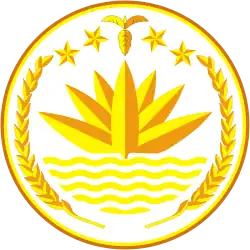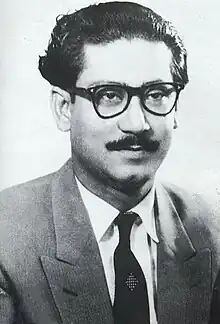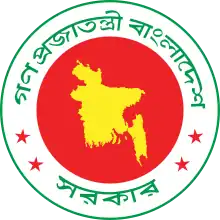| |||||||||||||||||||||||||||||||||
300 of the 315 seats in the Jatiya Sangsad 151 seats needed for a majority | |||||||||||||||||||||||||||||||||
|---|---|---|---|---|---|---|---|---|---|---|---|---|---|---|---|---|---|---|---|---|---|---|---|---|---|---|---|---|---|---|---|---|---|
| Registered | 35,205,642 | ||||||||||||||||||||||||||||||||
| Turnout | 54.91% | ||||||||||||||||||||||||||||||||
| |||||||||||||||||||||||||||||||||
| |||||||||||||||||||||||||||||||||
| This article is part of a series on the |
| Politics of the People's Republic of Bangladesh |
|---|
 |
|
|
|
|
General elections were held in newly independent Bangladesh on 7 March 1973. The result was a victory for the Bangladesh Awami League, who won 293 of the 300 directly elected seats, including eleven constituencies where they were elected unopposed without a vote.[1][2] Voter turnout was 55%.
Though the Awami League was already the clear favourite before the elections, Sheikh Mujib's government put major effort into winning every seat. This led to a nearly complete obliteration of the opposition, with most of the leadership of opposition parties failing to win seats, including Major Jalil (Jatiya Samajtantrik Dal), Rashed Khan Menon, Kazi Zafar Ahmed and Aleem al-Razee (National Awami Party (Bhashani)), and Suranjit Sengupta (National Awami Party (Muzaffar)).[3]
Conduct
Prior to the elections, some opposition candidates in marginal constituencies were kidnapped by Awami League supporters before they were able to submit their nomination papers. In some constituencies where opposition candidates were leading in the vote count, counting was abruptly stopped, ballot boxes were stuffed with fake papers, and the Awami League candidates were declared winners amid the strong presence of Awami League volunteers.[4]
However, it was generally believed that Awami League, with the appeal of its leader Sheikh Mujib and its instrumental role in the independence of Bangladesh, would have easily won the elections without manipulation.[4]
Results
 | ||||||||
|---|---|---|---|---|---|---|---|---|
| Party | Votes | % | Seats | |||||
| General | Reserved | Total | +/– | |||||
| Awami League | 13,798,717 | 73.20 | 293 | 15 | 308 | +10 | ||
| National Awami Party (Muzaffar) | 1,569,299 | 8.32 | 0 | 0 | 0 | New | ||
| Jatiya Samajtantrik Dal | 1,229,110 | 6.52 | 1 | 0 | 1 | New | ||
| National Awami Party (Bhashani) | 1,002,771 | 5.32 | 0 | 0 | 0 | New | ||
| Bangladesh Jatiya League | 62,354 | 0.33 | 1 | 0 | 1 | +1 | ||
| Bangla Jatiya League | 53,097 | 0.28 | 0 | 0 | 0 | New | ||
| Communist Party of Bangladesh | 47,211 | 0.25 | 0 | 0 | 0 | New | ||
| Sramik Krishak Samajbadi Dal | 38,421 | 0.20 | 0 | 0 | 0 | New | ||
| Bangladesh Communist Party (Leninist) | 18,619 | 0.10 | 0 | 0 | 0 | New | ||
| Bangladesh Shramik Federation | 17,271 | 0.09 | 0 | 0 | 0 | New | ||
| Banglar Communist Party | 11,911 | 0.06 | 0 | 0 | 0 | New | ||
| Bangla Chattra Union | 7,564 | 0.04 | 0 | 0 | 0 | New | ||
| Bangladesh Jatiya Congress | 3,761 | 0.02 | 0 | 0 | 0 | New | ||
| Jatiya Ganatantrik Dal | 1,818 | 0.01 | 0 | 0 | 0 | New | ||
| Independents | 989,884 | 5.25 | 5 | 0 | 5 | –2 | ||
| Total | 18,851,808 | 100.00 | 300 | 15 | 315 | +5 | ||
| Valid votes | 18,851,808 | 97.53 | ||||||
| Invalid/blank votes | 477,875 | 2.47 | ||||||
| Total votes | 19,329,683 | 100.00 | ||||||
| Registered voters/turnout | 35,205,642 | 54.91 | ||||||
| Source: Nohlen et al., Government of Bangladesh, Kumar Panday | ||||||||
Vote share by district
| District | BAL | NAP-M | NAP-B | JSD | Others |
|---|---|---|---|---|---|
| Rangpur | 77.03 | 10.56 | 6.39 | 1.51 | 4.50 |
| Dinajpur | 78.52 | 8.30 | 4.56 | 0.76 | 7.86 |
| Bogra | 74.91 | 16.94 | 2.20 | 2.23 | 3.66 |
| Rajshahi | 74.93 | 8.95 | 4.23 | 8.45 | 3.44 |
| Pabna | 84.89 | 4.72 | 1.35 | 4.59 | 4.45 |
| Kushtia | 76.03 | 10.10 | 7.59 | 6.28 | – |
| Jessore | 77.44 | 3.29 | 9.14 | 6.33 | 3.80 |
| Khulna | 74.03 | 3.19 | 12.71 | 5.91 | 4.16 |
| Patuakhali | 73.14 | 14.07 | 1.09 | 1.09 | 10.61 |
| Bakerganj | 71.21 | 7.92 | 8.47 | 10.25 | 2.15 |
| Tangail | 56.42 | 5.28 | 16.82 | 19.44 | 2.03 |
| Mymensingh | 71.44 | 15.02 | 1.15 | 8.74 | 3.65 |
| Dacca | 76.05 | 7.37 | 3.51 | 5.62 | 7.45 |
| Faridpur | 87.90 | 3.42 | 0.81 | 2.76 | 5.10 |
| Sylhet | 67.70 | 14.40 | 3.56 | 4.79 | 9.55 |
| Comilla | 70.09 | 7.44 | 2.89 | 3.70 | 15.88 |
| Noakhali | 64.88 | 2.26 | 2.14 | 20.41 | 10.31 |
| Chittagong | 61.73 | 7.57 | 13.78 | 12.01 | 4.92 |
| Chittagong H.T. | 28.43 | 5.24 | 2.37 | 2.97 | 60.99 |
| Source: Moten[5] | |||||
See also
References
- ↑ Dieter Nohlen, Florian Grotz & Christof Hartmann (2001) Elections in Asia: A data handbook, Volume I, p535 ISBN 0-19-924958-X
- ↑ Government of Bangladesh (1991). A Background Paper on Bangladesh Parliamentary Elections. Dhaka: Press Information Department (Handout No. 429).
- ↑ Jahan, Rounaq (1974). "Bangladesh in 1973: Management of Factional Politics". Asian Survey. 14 (2): 125–35. doi:10.2307/2643085. JSTOR 2643085 – via JSTOR.
- 1 2 Maniruzzaman, Talukder (1975). "Bangladesh: An Unfinished Revolution?". The Journal of Asian Studies. Cambridge University Press. 34 (4): 891–911. doi:10.2307/2054506. ISSN 0021-9118. JSTOR 2054506. S2CID 154434833.
- ↑ Moten, A. Rashid (1981). "Parliamentary Elections in Bangladesh". The Indian Journal of Political Science. 42 (2): 58–73. JSTOR 41855836 – via JSTOR.



